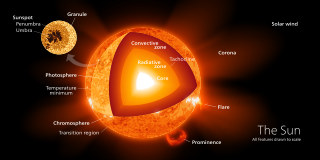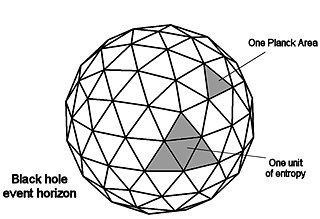
In fluid mechanics, hydrostatic equilibrium is the condition of a fluid or plastic solid at rest, which occurs when external forces, such as gravity, are balanced by a pressure-gradient force. In the planetary physics of Earth, the pressure-gradient force prevents gravity from collapsing the planetary atmosphere into a thin, dense shell, whereas gravity prevents the pressure-gradient force from diffusing the atmosphere into outer space. In general, it is what causes objects in space to be spherical.
In fluid mechanics, the Grashof number is a dimensionless number which approximates the ratio of the buoyancy to viscous forces acting on a fluid. It frequently arises in the study of situations involving natural convection and is analogous to the Reynolds number.

A Fermi gas is an idealized model, an ensemble of many non-interacting fermions. Fermions are particles that obey Fermi–Dirac statistics, like electrons, protons, and neutrons, and, in general, particles with half-integer spin. These statistics determine the energy distribution of fermions in a Fermi gas in thermal equilibrium, and is characterized by their number density, temperature, and the set of available energy states. The model is named after the Italian physicist Enrico Fermi.

Stellar dynamics is the branch of astrophysics which describes in a statistical way the collective motions of stars subject to their mutual gravity. The essential difference from celestial mechanics is that the number of body

The Kelvin–Helmholtz mechanism is an astronomical process that occurs when the surface of a star or a planet cools. The cooling causes the internal pressure to drop, and the star or planet shrinks as a result. This compression, in turn, heats the core of the star/planet. This mechanism is evident on Jupiter and Saturn and on brown dwarfs whose central temperatures are not high enough to undergo hydrogen fusion. It is estimated that Jupiter radiates more energy through this mechanism than it receives from the Sun, but Saturn might not. Jupiter has been estimated to shrink at a rate of approximately 1 mm/year by this process, corresponding to an internal flux of 7.485 W/m2.
In astrophysics, dynamical friction or Chandrasekhar friction, sometimes called gravitational drag, is loss of momentum and kinetic energy of moving bodies through gravitational interactions with surrounding matter in space. It was first discussed in detail by Subrahmanyan Chandrasekhar in 1943.

The Friedmann equations are a set of equations in physical cosmology that govern the expansion of space in homogeneous and isotropic models of the universe within the context of general relativity. They were first derived by Alexander Friedmann in 1922 from Einstein's field equations of gravitation for the Friedmann–Lemaître–Robertson–Walker metric and a perfect fluid with a given mass density ρ and pressure p. The equations for negative spatial curvature were given by Friedmann in 1924.

A radiation zone, or radiative region is a layer of a star's interior where energy is primarily transported toward the exterior by means of radiative diffusion and thermal conduction, rather than by convection. Energy travels through the radiation zone in the form of electromagnetic radiation as photons.
The classical electron radius is a combination of fundamental physical quantities that define a length scale for problems involving an electron interacting with electromagnetic radiation. It links the classical electrostatic self-interaction energy of a homogeneous charge distribution to the electron's relativistic mass-energy. According to modern understanding, the electron is a point particle with a point charge and no spatial extent. Nevertheless, it is useful to define a length that characterizes electron interactions in atomic-scale problems. The classical electron radius is given as
Nuclear density is the density of the nucleus of an atom. For heavy nuclei, it is close to the nuclear saturation density nucleons/fm3, which minimizes the energy density of an infinite nuclear matter. The nuclear saturation mass density is thus kg/m3, where mu is the atomic mass constant. The descriptive term nuclear density is also applied to situations where similarly high densities occur, such as within neutron stars.

In physics, the Bekenstein bound is an upper limit on the thermodynamic entropy S, or Shannon entropy H, that can be contained within a given finite region of space which has a finite amount of energy—or conversely, the maximal amount of information required to perfectly describe a given physical system down to the quantum level. It implies that the information of a physical system, or the information necessary to perfectly describe that system, must be finite if the region of space and the energy are finite. In computer science this implies that non-finite models such as Turing machines are not realizable as finite devices.

A gravity train is a theoretical means of transportation for purposes of commuting between two points on the surface of a sphere, by following a straight tunnel connecting the two points through the interior of the sphere.
Some of the basic concepts of general relativity can be outlined outside the relativistic domain. In particular, the idea that mass–energy generates curvature in space and that curvature affects the motion of masses can be illustrated in a Newtonian setting. We use circular orbits as our prototype. This has the advantage that we know the kinetics of circular orbits. This allows us to calculate curvature of orbits in space directly and compare the results with dynamical forces.
A Maclaurin spheroid is an oblate spheroid which arises when a self-gravitating fluid body of uniform density rotates with a constant angular velocity. This spheroid is named after the Scottish mathematician Colin Maclaurin, who formulated it for the shape of Earth in 1742. In fact the figure of the Earth is far less oblate than Maclaurin's formula suggests, since the Earth is not homogeneous, but has a dense iron core. The Maclaurin spheroid is considered to be the simplest model of rotating ellipsoidal figures in hydrostatic equilibrium since it assumes uniform density.

The gravity of Earth, denoted by g, is the net acceleration that is imparted to objects due to the combined effect of gravitation and the centrifugal force . It is a vector quantity, whose direction coincides with a plumb bob and strength or magnitude is given by the norm .

In stellar physics, the Jeans instability causes the collapse of interstellar gas clouds and subsequent star formation, named after James Jeans. It occurs when the internal gas pressure is not strong enough to prevent gravitational collapse of a region filled with matter. For stability, the cloud must be in hydrostatic equilibrium, which in case of a spherical cloud translates to
In astrophysics, the Tolman–Oppenheimer–Volkoff (TOV) equation constrains the structure of a spherically symmetric body of isotropic material which is in static gravitational equilibrium, as modeled by general relativity. The equation is
The Navarro–Frenk–White (NFW) profile is a spatial mass distribution of dark matter fitted to dark matter halos identified in N-body simulations by Julio Navarro, Carlos Frenk and Simon White. The NFW profile is one of the most commonly used model profiles for dark matter halos.
In astrophysics, the virial mass is the mass of a gravitationally bound astrophysical system, assuming the virial theorem applies. In the context of galaxy formation and dark matter halos, the virial mass is defined as the mass enclosed within the virial radius of a gravitationally bound system, a radius within which the system obeys the virial theorem. The virial radius is determined using a "top-hat" model. A spherical "top hat" density perturbation destined to become a galaxy begins to expand, but the expansion is halted and reversed due to the mass collapsing under gravity until the sphere reaches equilibrium – it is said to be virialized. Within this radius, the sphere obeys the virial theorem which says that the average kinetic energy is equal to minus one half times the average potential energy, , and this radius defines the virial radius.

In astrophysics, the Emden–Chandrasekhar equation is a dimensionless form of the Poisson equation for the density distribution of a spherically symmetric isothermal gas sphere subjected to its own gravitational force, named after Robert Emden and Subrahmanyan Chandrasekhar. The equation was first introduced by Robert Emden in 1907. The equation reads






























